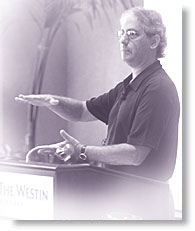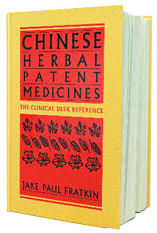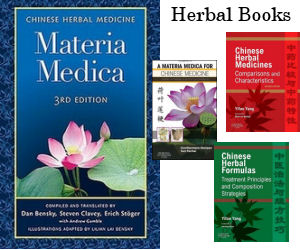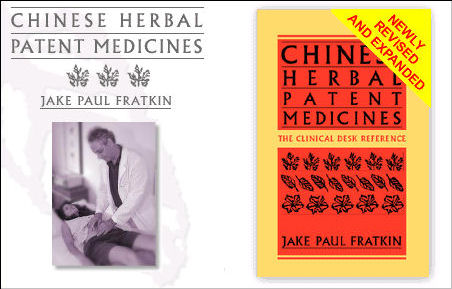Acupuncture & TCM Articles

Articles by Jake Paul Fratkin, OMD, LAc
Jake Fratkin, OMD, LAc, has been in the practice of Oriental medicine since 1978. Following undergraduate and graduate training at the University of Wisconsin in Chinese language and philosophy and pre-medicine, he pursued a seven-year apprenticeship in Japanese and Korean style acupuncture with Dr. Ineon Moon and a two-year apprenticeship in Chinese herbal medicine with Drs. Zhengan Guo and Pak-Leung Lau in Chicago. He also spent a year in Beijing hospitals interning in advanced herbal medicine, specializing in gastrointestinal and respiratory disorders, and pediatrics.  Dr. Fratkin is the author of several books, including Chinese Herbal Patent Medicines: The Clinical Desk Reference, and is the editor-organizer of Wu and Fischer's Practical Therapeutics of Traditional Chinese Medicine. In 1999, he was named the "Acupuncturist of the Year" by the American Association of Oriental Medicine.
Dr. Fratkin is the author of several books, including Chinese Herbal Patent Medicines: The Clinical Desk Reference, and is the editor-organizer of Wu and Fischer's Practical Therapeutics of Traditional Chinese Medicine. In 1999, he was named the "Acupuncturist of the Year" by the American Association of Oriental Medicine.
Chinese Herbal Patent Medicines: The Clinical Desk Reference
Hardback book, 1198 pages. This volume covers 1360 products, including 550 GMP level products and all of California FDB analysis on 505 products. Includes information on endagered animals, heavy metals, and pharmaceuticals. The text is organized into 12 groups, with a total of 109 chapters and includes material by Andrew Ellis, Subhuti Dharmananda, and Richard Ko. Over 80 pages of full-color photos (with English and Chinese cross-reference). Fully indexed.
The Treatment of Pertussis (Whooping Cough) With Chinese Herbal Medicine
Part Two: Risks and Benefits of Vaccinations
The discussion of pertussis would be incomplete without some comments regarding vaccinations. The DPT (diphtheria-pertussis-tetanus) vaccine is given in three injections. The first is recommended at 2, 4 or 6 months of age; the second at 15 or 18 months; and the third between 4 years and 6 years of age. There is no question that the pertussis vaccination has greatly reduced the incidence of pertussis. "If we stopped pertussis immunizations in the U.S., we would experience a massive resurgence of pertussis disease. A recent study found that in eight countries where immunization coverage was reduced, incidence rates of pertussis surged to 10 to 100 times the rates in countries where vaccination rates were sustained."1
Pertussis can be very serious for newborns and the death incidence is more pronounced in the elderly. However, the risk of death from pertussis is quite low. In the last major outbreak, which affected 13,000 people in Japan in 1979, there were 41 deaths, all among the elderly.2 In truth, pertussis can seriously inconvenience the patient and their families for up to three months, but is not a fatal disease. In Colorado, it is estimated that 40 percent of children are not vaccinated against pertussis, but it still only manifests as isolated cases, not raging epidemics.

The argument for vaccination is that whooping cough is common, virulent and incapacitating to the patient and the parents for several months. Once, when I treated a 6-month-old for pertussis, the mother had not gotten any sleep for weeks, and was becoming an emotional wreck. I had to ask myself, "Might it not have been better to have the vaccine?"
The bigger question is risk versus benefit of immunization. If there were no vaccine, large outbreaks could surely arise. In reality, most Americans are getting this vaccine and the risk of exposure is low. The question has to be directed to the individual patient's parents, and there will be those who refuse or postpone vaccination.
The DPT vaccine is not without risk. Numerous studies have linked this triple vaccine with illness. One study of 1,265 children included 23 who received no DPT immunization. A large group (23 percent) of the immunized children eventually developed asthma or allergic illness, but none of the children without the DPT vaccination developed asthma or allergic illness.3 The asthma epidemic in the developed world may very well have to do with early DPT vaccination.
The risk of dying from pertussis is one in several million. The risk of a serious adverse reaction from the vaccine is one in 1,750, and deaths attributed to the vaccine far outnumber deaths due to the illness.4 This is based on use of the newer acellular pertussis vaccine, which is much safer than the previous one used up to 1996.
Finally, the vaccine probably loses its protectiveness after 10 to 15 years. In a study from Australia, up to 32 percent of teenagers and adults having a cough longer than two weeks in duration were shown to have pertussis. The study authors felt that secondary vaccination as a teen or adult would confer lifelong immunity.5
Any risk with the DPT shot is compounded by the multiple vaccinations required or recommended by the Western medical establishment. Currently, seven vaccinations are strongly recommended in the first five months of life, and an additional 10 vaccinations are recommended between the ages of 6 months and 15 months. This puts a significant stress on an infant's developing immunological system. Other vaccines pose their own problems due to the inclusion of thimerosal (which contains 50 percent mercury) as a preservative, or live-virus vaccines such as MMR (measles-mumps-rubella), chickenpox and Sabin polio.6 The DPT vaccine uses neither thimerosal nor live virus.
In Chinese medicine, it is thought that the immunological system develops slowly and is not mature until age 3 at the earliest. Serious consequences associated with vaccination seem to be due to vaccinations given in the first year, especially the first six months. In my practice, I feel early vaccination plays a part in asthma, eczema, autism and ADD. Postponement of vaccinations until after age 3, or even age 5, seems reasonable. A published protocol to reduce risk recommends introduction of single vaccinations starting at age 2, each separated by six months.7 I agree with this. I am not unequivocally against vaccinations, because they offer real benefit against epidemic illness. However, they should be given singly, spaced out in time, and can start after age 3. Exceptions are during risks of local epidemics, such as pertussis, when combined with early enrollment in day care.
The vaccination issue is a big one, and I recommend further reading on the topic (see bibliography/recommended reading list below).
Conclusion
Pertussis, or whooping cough, is a very serious cough, and can be ameliorated or cured with Chinese herbal medicine. The clinical management of pertussis points out certain guidelines that should be important to the conscientious and well-trained herbal practitioner.
First, when confronting any serious disorder, it is important to hit the books. After 27 years of practice, I do not hesitate to look at herbal protocols established and recommended from doctors in mainland China. This is the land of the herbal masters, honed not only by their knowledge of the classics, but also by their vast clinical experience of treating hundreds of millions of patients every year. We have available in English many, many books from China on herbal treatment, and the conscientious practitioner needs to have these books on hand for immediate reference.
Second, cough needs to be treated according to its presentation, keeping in mind its etiology. Think of any cough as being a point on a graph that relates viscosity of phlegm (watery to thick to dry) with temperature (cold to hot). Choose herbs that relate to the presentation and you cannot fail, taking into account that phlegm presentations and their treatments change often. The patient should be re-evaluated weekly.
Third, in any disorder involving outside pathogenic microbes, employ herbs that kill viruses (clear heat and resolve toxin) or bacteria (dispel damp heat). There is hesitation by some practitioners who feel that cold herbs will injure spleen qi, but in an otherwise healthy individual laid low by an infection, between three days and 10 days of strong antimicrobial herbs, used within appropriate formulas, will kill the microbe without significantly damaging spleen qi. They certainly do not create the consequences of Western antibiotics.8
Cough can be stubborn in any case, and often needs time and persistence to resolve. Observing the effectiveness of herbal therapy in treating cough, including pertussis, I once again acknowledge that Chinese medicine is the greatest of all natural therapies.
References (for part one)
1 Centers for Disease Control. See www.cdc.gov/nip/publications/fs/gen/WhatIfStop.htm.
2 www.ndsc.ie/DiseaseTopicsA-Z/Vaccination/d266.PDF. Original article: Kanai K. Japan's experience in pertussis epidemiology and vaccination in the past thirty years. Japan J Med Sci Biol 1980;33:107-43.
3 Journal of Chinese Medicine, England. News #57, May 1998. Original study: Kemp T, Pearce N, Fitzharris P, Crane J, Fergusson D, St George I, Wickens K, Beasley R. Is infant immunization a risk factor for childhood asthma or allergy? Epidemiology 1997;8:678-680.
4 Reported in Mercola Web site: www.mercola.com/2001/aug/18/vaccine_myths.htm.
5 Clinical Infectious Diseases, Volume 39, No. 12, Dec. 15, 2004.
6 Ibid.
7 An excellent overview can be found in A User-Friendly Vaccination Schedule by Donald Miller Jr., MD. See: www.mercola.com/2004/dec/29/vaccination_schedule.htm.
8 For more on the consequences of antibiotics, see my article on pediatric ear infection at www.gfcherbs.com/pediatricear.asp?page=5.
Bibliography and Recommended Reading
- Chinese Herbal Medicine Materia Medica , 3rd ed. Dan Bensky, Steven Clavey and Erich Stšger, Eastland Press, Seattle, 2004. , 3rd ed. Dan Bensky, Steven Clavey and Erich Stšger, Eastland Press, Seattle, 2004.
- Chinese Medical Herbology and Pharmacology . John K. Chen and Tina T. Chen, Art of Medicine Press, City of Industry, 2003. . John K. Chen and Tina T. Chen, Art of Medicine Press, City of Industry, 2003.
- Essentials of Traditional Chinese Pediatrics . Foreign Language Press, Beijing, 1990. . Foreign Language Press, Beijing, 1990.
- The Merck Manual . Mark H. Beer, MD, and Robert Berkow, MD, eds. Merck Research Laboratories, Whitehouse Station, NJ. Published yearly. . Mark H. Beer, MD, and Robert Berkow, MD, eds. Merck Research Laboratories, Whitehouse Station, NJ. Published yearly.
- Notes From South Mountain. Andrew Ellis, The Moon Publishing, Berkeley, 2003.
- Paediatrics; The English-Chinese Encyclopedia of Traditional Chinese Medicine , Volume 13. Higher Education Press, Beijing, 1990. , Volume 13. Higher Education Press, Beijing, 1990.
- Treatment of Paediatric Diseases in Traditional Chinese Medicine . Hou Jinglun, ed. Academy Press, Beijing, 1995. . Hou Jinglun, ed. Academy Press, Beijing, 1995.
- The Vaccine Guide: Risks and Benefits for Children and Adults , revised edition. Randall Neustaedter, North Atlantic Books, Berkeley, 2002. , revised edition. Randall Neustaedter, North Atlantic Books, Berkeley, 2002.
 
| 